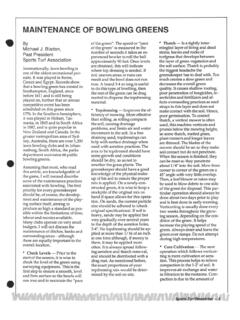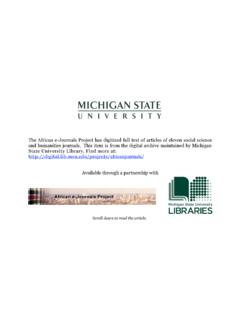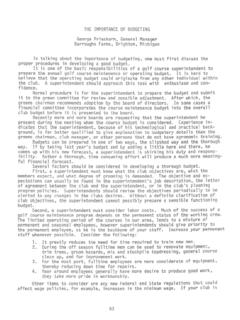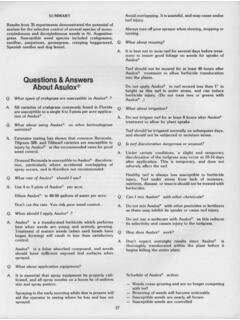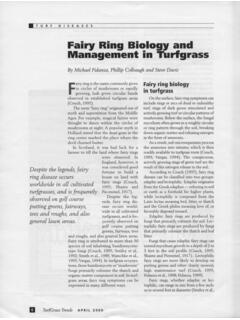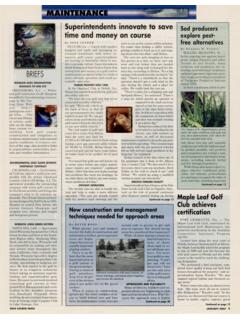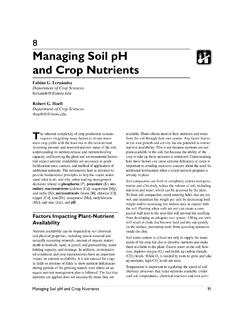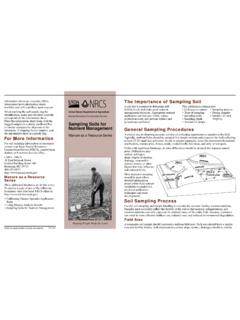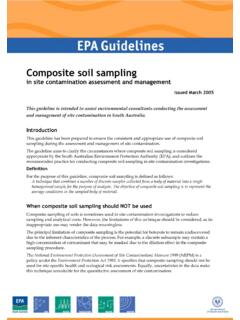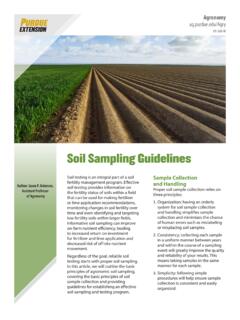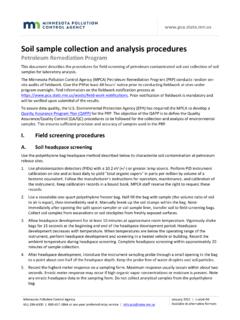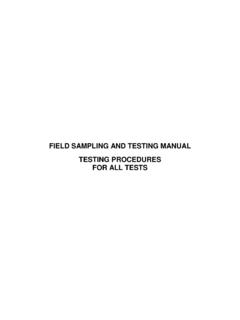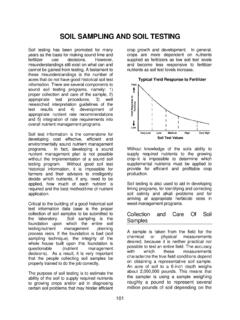Transcription of LITERATURE REVIEW: SOIL QUALITY 1.1INTRODUCTION
1 LITERATURE REVIEW: soil QUALITY . INTRODUCTION. Throughout the 1990' s interest in soil QUALITY and understanding its importance has come to the forefront of environmental sustainability. Over $25 billion is spent in the United States annually for soil care and improvement (Wallace & Terry, 1998). The terms soil QUALITY , soil degradation, soil health, and soil resilience are being used more frequently and with greater urgency in connection with strategies to protect our global environment. The needs to improve our QUALITY of life and protect many scarce natural resources are forcing society to recognize the importance of their soil resource. soil QUALITY is frequently over-looked in a society that places more emphasis on water and air QUALITY , likely because these resources have a more apparent connection to human health and existence. However, soil QUALITY and land management both have a direct influence on water and atmospheric QUALITY and, by extension, to human and animal health (Doran and Parkin, 1994; Kennedy & Papendick, 1995).
2 soil is a vital resource for producing the food and fiber needed to support an increasing world population (Pappendick & Parr, 1992). While seemingly a straight-forward concept, soil QUALITY has been difficult to define and more difficult to quantify (Karlen et aI., 1997). Many feel that soil QUALITY can not be defined for a complex system as diverse and dynamic as soils. " QUALITY " and " soil QUALITY " are seen by some to have infmite meanings and basically are indefinable (Sojka & Upchurch, 1999). Others, however, have taken on the challenge of converting a subjective term such as " soil QUALITY " into an objective characterize able term. The difficulty in establishing a definition comes from the variety of land uses, locations, environments, types of soils and general lack of understanding between the interactions 1. of a multitude of processes occurring within the soil (Kennedy & Papendick, 1995). The definition of soil QUALITY (and some may argue soil ) is controlled by a multitude of variables.
3 Additionally, not all involved accept the same terminology. soil QUALITY and soil health are often considered to have the same meaning (Chen, 1999). The term soil health is often preferred to soil QUALITY by farmers, while scientists relate the term " soil health". to the status of various biological properties in the soil (Haberem, 1992; Romig et aI., 1995; Harris et aI., 1996). A sound definition of soil QUALITY will find application over a broad range of situations. Initially, the definition of soil QUALITY has been agriculturally based. Some have defined soil QUALITY by the ability of the soil to serve as a natural medium for the growth of plants to maintain human and animal life (Karlen et al., 1992; Jazen et aI., 1992). Parr et aI. (1992) defined soil QUALITY as : Capability of soil to produce safe and nutritious foods and crops in a sustainable manner over the long term, and to enhance human and animal health without adversely impairing the natural resource base or adversely affecting the environment.
4 While agriculture is a vital use of our soil resource other environmental and recreational functions of soil also need to be considered. Soils serve as a medium for the global cycle of nutrients and energy. The soil plays an ecological role in the purification, detoxification, and decomposition of wastes and hazardous materials (Jazen et al., 1992). The role soils play in an urban environment have also been recognized with concern for the QUALITY of soils used on golf courses, lawns, and athletic fields (Koolen & Rossignol, 2. 1998; Huinink, 1998; Thien et aI., 2001). Doran and Parkin (1994) presented a function- based definition of soil QUALITY that was adopted by the soil Science Society of America. They define soil QUALITY as: The capacity of a soil to function within ecosystem boundaries to sustain biological productivity, maintains environmental QUALITY , and promotes plant and animal health. This definition focuses more on the general function of the soil rather then one specific use ( agriculture).
5 soil QUALITY has also been described as the balance between soil degradation and soil resilience (Kennedy & Papendick, 1992; Lal, 1998). soil resilience is the ability of soil to return to a dynamic equilibrium after being disturbed (Blum & Santelises, 1994). soil resilience is controlled by inherent soil properties governed by the factors affecting soil formation (Blum, 1998). soil degradation is the short to medium term deterioration of soil caused by land use, soil management, and the soil 's susceptibility to soil processes that promote loss of function (Blum, 1998; Lal, 1998). As a soil QUALITY definition is reached, it needs to be flexible to account for the numerous functions that soil may perform. Interactions among the basic soil forming factors of parent material, climate, organisms, topography, time and human activity produce an inherent and baseline soil QUALITY parameter (Karlen et al., 1992; Gregorich et aI.)
6 , 1994). Through measurement of various biological, physical and chemical indicators and their response to prevailing environmental conditions over time, an idea of soil QUALITY emerges. However, a composite value of all soil QUALITY indicators is difficult to conceptualize since 3. interactions between indicators are sometimes unknown and often difficult to quantify. Since integration of analytical results into one composite value can be overly complex, it remains difficult to assess whether the soil has improved, degraded, or remained unchanged (Granatstein and Bezdicek, 1992). Thus, it seems more realistic to measure soil characteristics that evaluate QUALITY based on the soil 's intended function. When any of the proposed indicators lie outside an ideal range, more specific tests can be conducted and/or trigger remediation steps. Assessing soil QUALITY raises many questions. How is soil QUALITY managed? What criteria should be used to evaluate soil QUALITY ?
7 Which soil QUALITY indicators should be used? How many indicators are needed to assess soil QUALITY ? What are the ideal conditions or values for each indicator? Can a composite value or status be determined? These questions illustrate just how difficult it can be to assess the QUALITY of soil in one specific location. For example, a soil with high clay content may be ideal in a semiarid region where soil moisture retention is beneficial but, in a humid region the same property might cause poor drainage and limit plant growth. Basically, there is no universally accepted definition of soil QUALITY or set of soil QUALITY criteria and optimum values. Further research needs to be conducted on smaller, local scales to produce parameters leading to a universal soil QUALITY evaluation. STEPS IN soil QUALITY EV ALUA TION. Little information is available on the QUALITY standards of every soil type under every environmental condition (Snakin et al.)
8 , 1996). Environmental QUALITY research is a 4. continual process. Thien (1998) listed six steps basic to a soil QUALITY management program: 1. Identification of critical soil -use functions, 2. Selection of indicators to evaluate these functions, 3. Analysis of indicators through soil sampling and testing, 4. Assessment of indicator status, 5. Recommendation of remedial management if needed, and 6. Monitoring changes to indicators. While these steps seem straightforward they don't produce a composite value of soil QUALITY . Some of the steps still require subjective inputs and establishment of arbitrary standards. Identification of Critical soil -Use Functions Understanding soil function and land use is the first step in the determination of soil QUALITY . The common component of the soil QUALITY definitions previously stated is that they relate soil QUALITY to the capacity of the soil to function effectively. Confusion over defining soil QUALITY is often the result of not identifying major issues of concern with respond to soil function (Doran and Parkin, 1994).
9 soil functions can be classed into four general categories; productivity and sustainability, environmental QUALITY , biodiversity, and human welfare (Doran and Parkin, 1994; Lal, 1998). Ultimately, when monitoring soil QUALITY , it is important to identify the specific and detailed functions a soil will perform. Identification of the soil function(s) will allow for easier identification of appropriate indicators to reflect soil QUALITY . 5. Selection of Indicators to Evaluate soil Function. Establishing the soil 's function leads to selection of soil QUALITY indicators. Any indicator criteria used to assess soil QUALITY should be practical and useful across a range of ecological and socio-economic situations (Doran and Parkin, 1996). soil QUALITY indicators should meet the following criteria (Doran & Parkin, 1996; Chen, 1999): 1. Correlate and encompass natural processes in the environment, 2. Integrate soil physical, chemical and biological characteristics and processes, 3.
10 Be easy to use and accessible for a broad range of users and field conditions, 4. Be sensitive to changes in management or environmental conditions, and 5. Be present in existing environmental databases when possible. Cameron et al. (1998) proposed applying these steps to a simple scoring system to decide , whether to accept a possible soil QUALITY indicator in the assessment of polluted soils. Their formula was: A = L(S, U,M,I,R). where: A = Acceptance level of the indicator S = Sensitivity of the indicator to changes from degradation or remediation U = Ease of use and/or understanding M = Cost effectiveness of measurement of the indicator I = Predictable influence of properties on soil , plant and animal health R = correlation and relationship to ecosystem processes In this equation each parameter is rated between 1 and 5 based on the user's understanding of that parameter. The sum of all the parameters gives the acceptance 6.


